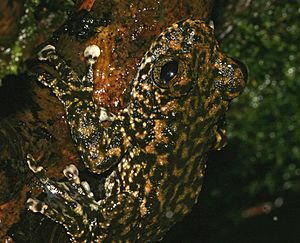Waterfall frog facts for kids
The waterfall frog (also called the torrent tree frog) is a special kind of frog that lives in Australia. Scientists have found these frogs living high up in the mountains, from about 180 to 1300 meters above sea level.
Quick facts for kids Waterfall frog |
|
|---|---|
 |
|
| Conservation status | |
| Scientific classification | |
| Genus: |
Ranoidea (genus)
|
| Species: |
nannotis
|
| Synonyms | |
|
|
Contents
About the Waterfall Frog
Adult male waterfall frogs are usually between 3.2 and 5.2 centimeters long. Female frogs are a bit bigger, measuring 4.8 to 5.9 centimeters long. These frogs live in rainforests and other forests. They prefer places with fast-flowing streams.
The adult frog's skin is often gray or olive green on its back. It has mottled (spotty) colors and a white belly. During the day, these frogs like to hide in the stream or near waterfalls. At night, they come out to look for food. They usually stay close to the water, not moving more than 35 meters away.
What Waterfall Frogs Eat
The waterfall frog eats almost any invertebrate (an animal without bones inside) that it can fit into its mouth. They are not picky eaters!
Their diet includes many different kinds of insects and other small creatures. They eat flies, dragonflies, beetles, true bugs, mites, bees, wasps, and ants. They also enjoy eating insect larvae (baby insects) and millipedes.
Reproduction and Life Cycle
Female waterfall frogs can lay their eggs at any time of the year. They lay their eggs safely underneath rocks in the fast-flowing streams.
The baby frogs, called tadpoles, are very strong swimmers. They have powerful tails that help them move through the water. Their mouths are on the underside of their bodies. This special mouth helps them hold onto rocks so they don't get washed away by the strong currents.
Why Waterfall Frogs Are Endangered
Sadly, the waterfall frog is an endangered animal. This means there are not many of them left, and they are at risk of disappearing forever. Scientists are trying to figure out exactly why their numbers are dropping.
One idea is that feral pigs might be causing problems. These pigs are not native to Australia; they were brought there by humans. They can rip up the streams where the frogs live, which destroys the frogs' homes.
Scientists have also looked into other possible reasons. They checked if losing their habitat (the places they live) or if pesticides (chemicals humans use to kill insects) were harming the frogs. So far, it seems these are probably not the main reasons the frogs are dying.
Some scientists believe a fungal disease called chytridiomycosis could be killing the frogs. This disease affects many frog species around the world.
Images for kids
-
Dorsal view of a waterfall frog in Far North Queensland, Australia
See also
 In Spanish: Rana de las cascadas australiana para niños
In Spanish: Rana de las cascadas australiana para niños



